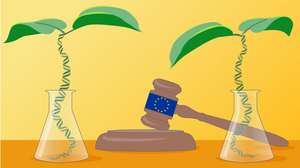Climate change and the earth's growing population are putting agriculture worldwide to the test. Breeding plants that are better able to cope with heat, drought or lack of nutrients could help to meet the demand for food. Plant biotechnology research has developed targeted mutagenesis techniques over the last 10 years: A genetic engineering method that can be used to create plant varieties with new characteristics. In July 2020, it has been two years since the ruling of the European Court of Justice on the regulation and approval of these processes. It sparked a media debate between supporters and opponents from research, industry, environmental and consumer protection associations and agriculture. In the project "Legal and Ethical Aspects of Control-of-Function Technologies" of the CIBSS - Centre for Integrative Biological Signalling Studies cluster of excellence at the University of Freiburg, Elisabeth Andersen and Katharina Schreiber at the chair of Prof. Dr. Silja Vöneky are dealing with this topic from a legal perspective. In two publications, which appeared in March in the journal 'Natur und Recht' (Nature and Law), the researchers analyse how the ruling is legally justified and assess the reactions and consequences of the court decision. In an interview with Mathilde Bessert-Nettelbeck they talk about their findings.
Targeted Mutagenesis In today's agriculture, new plant varieties are usually created by mutagenesis processes. With this techniques, breeders produce changes in the genetic material of plants. Conventional mutagenesis causes DNA changes at random: UV light or chemicals generate errors, i.e. mutations, at random locations in the DNA of the seeds. From the resulting plants, the breeder selects those with desirable characteristics and grow them further. A new method that changes DNA more precisely is targeted mutagenesis: DNA-cutting molecules such as CRISPR/Cas can be used to change the DNA of plants at predefined points. This method has been used in plant research for several years to develop new types of crops. However, whether and with what regulations these plant varieties should be brought to market in Europe is a matter of controversy in the public debate. Among scientists, the method is regarded as precise and as having few side effects. Mutagenesis differs from so-called transgenesis, another plant breeding method: In mutagenesis, no foreign DNA is introduced into the genome of the plant. |
How did the case come to the European Court of Justice?
Elisabeth Andersen & Katharina Schreiber: The basic question that the court case was supposed to answer was whether targeted mutagenesis processes are subject to are subject to the European legislation on genetic modifications.
Originally, French environmental associations brought an action before the French Conseil d'État against a paragraph of the French Environmental Code. This states that all organisms that are produced or modified by mutagenesis processes are legally not genetically modified organisms. But now the term "genetically modified organism" is actually defined in European law: in Directive 2001/18 EC, which regulates the release of genetically modified organisms. In order to ensure a uniform interpretation of the term in all EU member states, the ECJ is to determine which procedures this term covers.
“The legal argumentation of the European Court of Justice is, in our view, understandable.”
Elisabeth Andersen and Katharina Schreiber
How exactly have you examined the ruling?
Andersen & Schreiber: We have reviewed the ECJ proceedings and evaluated the scientific publications on the judgement and compiled them in a compact form. We also collected statements from the scientific public, trade organisations and industry associations. In particular, however, we assessed the ECJ's arguments in detail. We explained how this ruling is comprehensible from a legal perspective.
What did you find in your first publication?
Andersen & Schreiber : The judgment creates a more differentiated regulation of plant breeding. It stipulates that all mutagenesis procedures produce genetically modified organisms. Nevertheless, the so-called mutagenesis exception of Directive 2001/18/EC remains in place: Conventional methods do not need to be approved as genetically modified organisms because they are considered safe for consumers and the environment. On the other hand, the novel, targeted mutagenesis procedures do not fall under this exception because long-term experience is lacking. They therefore remain subject to existing European genetic engineering legislation. The legal argumentation of the European Court of Justice is, in our view, understandable. However, the ruling has also given rise to a great deal of criticism - there was little understanding, especially from a scientific perspective. From their point of view, treating mutagenesis procedures differently makes no sense. After all, the final product is a genetically identical plant. This makes it clear: in this judgement, science and law meet and this creates a conflict. Economic consequences are also possible: plants that fall under the 2001/18 EC directive require a lengthy and cost-intensive approval procedure and products made from them must be labelled as "produced with genetically modified organisms". This is not necessary for products from conventional mutagenesis. Farmers and plant breeders may then prefer to avoid using the new technology.
“In this judgement, science and law meet and this creates a conflict.”
Elisabeth Andersen and Katharina Schreiber
What was the focus of the second publication?
Andersen & Schreiber : We described the practical implications: What are the problems caused by the ECJ ruling today? We also analysed reform efforts. As a follow-up to and in response to the ECJ ruling, the German Bio-economy Council and the Leopoldina Academy of Science, for example, wrote in 2019 that they would like to see reforms of genetic engineering law.
Will these reforms take place?
Andersen & Schreiber : The European Council recently requested the European Commission to prepare a study. This is the first step towards a possible reform and the discussion is gaining momentum on an European level. Now, institutions and associations are being specifically asked how they assess the European genetic engineering law and how novel mutagenesis methods should be regulated. The corresponding study is to be completed in April 2021. When considering reforms, it must always be borne in mind that CRISPR/Cas will not be the last leap forward in development.
Scientists also criticized that the ruling would inhibit innovation and research in plant breeding. Was this fear justified?
Andersen & Schreiber: We could not find any direct restrictions on laboratory research as a result of the ECJ ruling. But biotechnology as a branch of research lives from the application of its results. For example, by bringing new plants onto the market. Before the ruling, there was already an approval in Germany for a specific breed created with targeted mutagenesis - this decision had to be revoked. For field research with plants, the judgement increases its requirements, since a release approval must first be acquired. The Leopoldina also criticises the fact that there are few prospects for young scientists. Germany and Europe could lose importance as a research and business location for biotechnology. At the same time, researchers consider this sector of the economy to be essential for tackling the most pressing issues of nutrition and climate change.
What is still allowed in Europe?
Andersen & Schreiber : It is important to stress that mutagenesis is allowed, including targeted mutagenesis. Only the resulting plants and products need to be approved and labelled as genetically modified organisms. In general, hardly any plant varieties that are considered genetically modified are cultivated in Europe, which is due to a cautious attitude towards green genetic engineering. Much more important economically, for example, is the import of feed from genetically modified soya. But even these imported products are not prohibited, but must be approved according to EU guidelines and labelled accordingly.
In your contribution, how do you assess the discourse that started and continues after the ruling?
Andersen & Schreiber : The fronts in the public debate have hardened. One aim of our work is to dissolve the black and white in the discussion. We do not want to look at the issue with a ready-made opinion such as "genetic engineering is bad" or "genetic engineering is good", but to assess from a legal perspective which arguments can be found for or against the applicability of the directive. This question must be answered primarily from a legal point of view. And: the discourse between research, industry, the public and consumers must take place. The EU is now promoting this communication, and we want to make our contribution to it. We must not forget that green genetic engineering was debated long before the ECJ ruling and that it is still a highly emotional topic.
What does the judgement say about whether targeted mutagenesis is now more risky than the conventional?
Andersen & Schreiber : The role of the court is not to assess the risk associated with a technology. The court assesses the presented facts with legal methodology under the applicable law. It is not about an ideal of what the law should look like, but how the case should be understood under the applicable rules.
So why can't experts be consulted?
Andersen & Schreiber : They can. It is also an important criticism of the judgment that the court did not do this sufficiently. The judges have referred to the comments of the French court. Legally this was not wrong and the genetic engineering law in the EU judges every process of plant breeding according to the principle: Does it have a "long safety record", so has it been established as safe, or is this just not the case? If it does not have this long safety record, it must first be approved instead. In this sense the legal argumentation is comprehensible.






